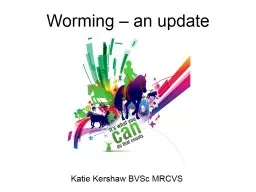

The worms Worm control The wormers Resistance RDA Plan The Worms Age Very young birth 2 months From the milk Clinical signs Diarrhoea lethargy reduced weight gain Prevention ID: 779033
Download The PPT/PDF document "Worming – an update Katie Kershaw BVSc..." is the property of its rightful owner. Permission is granted to download and print the materials on this web site for personal, non-commercial use only, and to display it on your personal computer provided you do not modify the materials and that you retain all copyright notices contained in the materials. By downloading content from our website, you accept the terms of this agreement.
Slide1
Worming – an update
Katie Kershaw BVSc MRCVS
Slide2The wormsWorm controlThe wormersResistanceRDAPlan
Slide3The Worms
Slide4Age: Very young (birth – 2 months)From the milk Clinical signs:Diarrhoea, lethargy, reduced weight gainPrevention:Treat mares before foaling?Treatment:IvermectinStrongyloids westeri – Threadworm
Slide5Age: 6 months +Pathology:Attach at ileocaecal junctionHyperaemia, mucosal thickening and necrotic ulcersClinical Signs:Colic?No signsTreatment:PyrantelPraziquantelPrevention:1 or 2 treatments a year?Tapeworms – Anoplocephala perfoliata
Slide6Faecal egg counts?Centrifugation?Flotation?Poor sensitivity/specificityELISA Blood – Uni of Liverpool and RossdalesSaliva – EquisalExposed in last 5 monthsTapeworm Diagnosis
Slide7Age: 5 months +Pathology:Irritant proteinaceous uterine fluid, egg masses or more complex?Clinical signs:Itchy bottom!Diagnosis:Protruding from rectum? Sticky tape - microscopeNOT FECTreatment:WormerCleaning, disinfectionPreventionPinworm – Oxyuris equi
Slide8Pinworm Lifecycle
Crypts of Lieberkuhn
Ventral Colon
Right Dorsal Colon
Slide9Age: anyClinical signs:Yellow dots on legsSignificance?TreatmentIvermectin/moxidectin Autumn/Winter – larvae in host Bots - Gasterophilus
Slide10Common in donkeys (supports the whole life cycle)Clinical signsFew in donkeysCoughing, breathing difficulties and inappetance in horsesDiagnosisFEC SedimentationTest the donkeys not horses (few adults in horses)TreatmentIvermectin/moxidectinLungworm – Dictyocaulus arnfieldi
Slide11Usually sheep and cattleIndirect life-cycle – Galba truncatulaClinical signs:Weight loss/inappetance Raised liver parametersDiagnosis:FEC – low sensitivity Serum ELISA – unknown sensitivity/specificity Treatment:Triclabendazole 12mg/kg PO – resistance?!Liver Fluke
Slide12Age: 6 months +Rare in UK now – Denmark?Pathology:Migration – intestinal wallLarvae in arterioles – thromboembolic infarctionsClinical signs:Weight lossColicTreatment:Most wormers – no resistance knownPrevention:Paddock maintenanceLarge Strongyles – Strongylus vulgaris
Slide13Small Strongyles – Cyathostomins - Redworm
Slide14Virtually ALL grazing horses exposed5-10 common typesNone?MalaiseWeight lossAnorexiaColicClinical Signs
Slide15L3 → HYPOBIOSIS= “early L3”Host immunity?Cold conditioning?Population density?Autumn/WinterLow/negative FECRe-emergenceLarval cyathostominosisSudden weight loss, oedema, diarrhoeaFatal in up to 50% casesSpringThe Encysted Stage
Slide16FECTotal protein + albumin on bloodsBlood test (ELISA) for encysted?In developmentMany strains Immune response not current infectionAutumn/Winter testing?Diagnosis
Slide17De-wormingIvermectinMoxidectin?PyrantelFenbendazole?!Anti-inflammatories?Fluid therapy?Treatment
Slide18Appropriate stockingPoo-picking – > 2x/weekMixed grazingSeparate dung heapsPasture rotation?Survival 6-9 months - strongylesYears - ascaridsRest pastureOnly in very hot weatherHarrowing?Spread contaminationNot hot enough to killPrevention Strategies
Slide19Moxidectin + Praziquantel on arrivalLeast evidence of resistanceQuarantined ≤ 3 days post treatmentDon’t spread faecesFECRT after 10-14 days?Quarantine
Slide20IvermectinMoxidectinPyrantelFenbendazolePraziquantelThe Wormers
Slide21StrongylesNo need Unless environmental issuesParascaris3 days?How long to stable a horse after worming?
Slide22DrugCyathostominsLarge StrongylesAscaridsIvermectin
Emerging resistance
Full efficacy
Wide-spread resistance
Moxidectin
Emerging resistance
Full efficacy
Wide-spread resistance
Fenbendazole
Wide-spread resistance
Full efficacy
A few published cases
Oxibendazole
Wide-spread resistance
Full efficacy
Full efficacy
Pyrantel
Some resistance
Full efficacy
A few published cases
Resistance
Slide23Rotating products?Doesn’t influence development of resistanceCombining products? Doesn’t influence development of resistanceRefugiaOnly treating a select proportion of the populationOnly treat if high enough FEC?Preventing resistance?
Slide24Faecal Egg CountsThe FEC does NOT directly correlate with number of wormsBelow 500epg – number of worms likely to be lowDetermination of egg shedding→ Who is contaminating the pastureUseful in grazing season!FEC reduction testingAscarids vs strongylesClinical diagnosis?Larval stages!
Slide25Tapeworm ??Pinworm Lungworm Liver fluke Cyathostomins in horses under 4 yearsEncysted cyathostomins (encysted red worm) In UK only encysted in Winter”After first frost”Blood test in developmentPost mortem Limitations
Slide26Savings £57-£568 per yard/year18% horses required treatment”High chance of reducing the financial costs”Costs?
Slide273 x between March and September>3 faecal balls and mixAir-expelled containerRefrigerate within 12 hoursTested within 5 daysQuantitative technique Vet External labHow to take a sample
Slide28Redworm vs Roundworm vs Tapeworm<200epg = LOWDoesn’t currently require treatment250epg – 1200epg = MEDIUMRequires treatment1200+ = HIGHMay need additional or different treatmentsDiscuss with own vetInterpretation
Slide29Direct order from websiteSwab in mouth where bit sitsSend awayTests for ANTIBODIES to the tapeworm+ve = exposed in last 5 months-ve = not exposed in last 5 monthsEquisal
Slide30SpringFEC for ascarids and cyathostominsEquisal for tapeworm?SummerFEC for ascarids and cyathostominsAutumnFEC for ascarids and cyathostominsEquisal for tapewormWinter
Worm against encysted cyathostomins Test for resistance?
Targeted Approach to Worming
Slide31Faecal Egg Count£5.50 + VAT (£6.60)(Usually £9.95 per horse)Equisal£12 + VAT (£14.40)(Usually £17.95 per horse)Per horse = 3 x FEC + 2 x Equisal = £48.60Minimum = 2 x FEC + 1 x Equisal = £27.60OR… 2-3 x FEC then tape wormer in Winter with moxidectin (Equest Pramox)Westgate Labs
Slide32Complementary worming MOT25% off FEC15% off wormers50% off monthly fee (£1 instead of £2 per horse)Intelligent Worming
Slide33Many practices perform their own FECIndividual groups may wish to ask for prices/discount for charity themselves if used to using vetsMany practices will be happy to discuss FEC from other companies if approached in the right way!The Veterinary Surgeon
Slide34RDA
Slide35Create relationships with Westgate/IWDiscounted FECDiscounted EquisalRDA specific form to encourage useEducation programme of need for targeted wormingThe Aim
Slide36Thank you Lets come up with a plan…